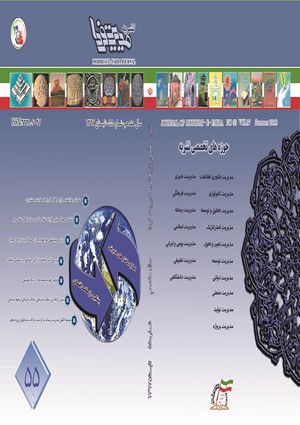توسعه مدل کسب و کار با محوریت شرکت مرکزی در کسب و کارهای مبتنی بر شبکههای همکاری
محورهای موضوعی : مدیریت استراتژیک
1 - دانشگاه علم و صنعت
کلید واژه: شبکه, شرکت مرکزی, مزیت مادری, عملکرد شرکت مرکزی, همکاریهای بلندمدت, استراتژی های مبتنی بر شبکه,
چکیده مقاله :
چکیده: توسعه سازمانهای شبکهای معمولاً با تولیت یک بنگاه مرکزی (مادر) پی گرفته میشود، بدین منظور بنگاه مادر به عنوان مرکزیت اصلی شبکه باید استراتژیهای خود را با راهکاری عملیاتی در سطح شبکه پیاده سازی کند اهمیت مدل کسبوکار در شبکه تا آنجا مهم است که بسیاری از صاحبنظران مدل کسبوکار را موتور استراتژیهای مبتنی بر شبکه میدانند. در پژوهش حاضر، با نگاه به موضوع شبکههای همکاری، به بررسی، شناسایی و اولویت بندی نقش سازمان مادر در مدل کسب و کاری شبکههای همکاری پرداخته شده است. در این راستا با مرور ادبیات مربوط به مزیت مادری عملکردهای کلیدی شرکت مادر در بحث کسب و کاری شبکهها استخراج گردید سپس با استفاده از روش دلفی و در سه دور به استحضار خبرگان فعال در حوزه شبکههای همکاری قرار گرفت و بهبود و توسعه یافت. پس از تائید فاکتورهای نهایی توسط خبرگان بهمنظور اعتبارسنجی و اولویت بندی فاکتورها پرسشنامهای تدوین و در اختیار خبرگان دانشگاهی و مدیران دو شبکه همکاری قرار گرفت. که نتایج به کاربردی و عملیاتی بودن فاکتورها تدوینشده صحه میگذارد.
The development of networked organizations usually done by a focal firm (the mother). For this purpose, the focal firm as the main center of network must implement her strategies with an action plan. Significance of business model in a network is important as many experts realize business model as an engine for network base strategy. In the present study, we look at the subject of collaboration networks , to review, identify and prioritize the role of focal firm in the business model of collaboration networks. In this direction, by reviewing existing literature on maternal advantage we extract the key functions of focal firm in her mothering strategy and business model. Then the extracted factors in Delphi process was judged and developed by experts. After confirming the final factors by experts to further validation and extract the Priority of factors we design questionnaires that given to Academic experts and managers who working in two network, the result of that questionnaires approved the applicability of the model
• Brekke, K.A. Kverndokk, S. Nyborg, K. 2003. An economic model of moral motivation. Journal of Public Economics 87 (9-10), 1967–1983.
• Cummings, Thomas G. And Christopher G. Worley (۲۰۰۱) Organization Development and Change. Cincinnati: Thomson leartning.· Daft, Richard L. (۲۰۰۱) Organization Design and Theory, ۷th edition. Cincinnati, Ohio: Thomson Learning.
• DaSilva Carlos M. Peter Trkman, Business Model: What it is and What it is Not,2013,Long Range Planning, Forthcoming
• Galbraith, Jay R. (۲۰۰۲) Designing Organizations: An Executive Guide to Strategy, Structure, and process. San Francisco, CA: Jossey – Bass
• Gibson, James. lvancevich, John M. and James H. Donnelly (۲۰۰۲) Organizations; Behavior, Structure, processes, ۱۱th edition. Boston: lrwin/McGraw - Hill.
• Mohr, Jakki (۲۰۰۱) Marketing of High - Technology products and lnnovations. Upper Saddle River, New Jersey: prentice - Hall.
• Osterwalder, (2004). “THE BUSINESS MODEL ONTOLOGY A PROPOSITION IN A DESIGN SCIENCE APPROACH” PHD thesis, Lausane Universty.
• Osterwalder, A. Pigneur, Y. & L.Tucci, C. (2005). Clarifying business models: origins, present, and future of the concept. Communications of the Association for Information Systems, 16, 1-25
• Raymond, E. Miles. (2009) THE FUTURE. University of California, the Hass school of business.
• Rechtin, Eberhardt (۲۰۰۰) System Architecting of Organizations. Florida, Boca Raton: CRC Press
• Romero,D, Nathalie Galeano, 2Arturo Molina, j. (2013) VO BREEDING ENVIRONMENTS VALUE SYSTEMS, BUSINESS MODELS AND GOVERNANCE RULES. Boston-Dordrecht-London: Kluwer Academic Pub. 2004.
• Zott C, Amit R. The fit between product market strategy and business model: Implications for firm performance. Strategic Management Journal 2008; 29: 1-26.
• Zott, C. & Amit, R. (2002). Measuring the performance implications of business model design: evidence from emerging growth public firms”,Fontainebleau, France. INSEAD Working Paper Series, 1-48.
• Zott, C. & Amit, R. (2009). “The Business Model as the Engine of Network-Based Strategies”,Fontainebleau.
• رحمیان، ح. (1390). طراحی و توسعه سازمانهای شبکهای. مجله مدیر ساز، سال ششم


